The abundant rain of late has been good for all things green and growing. Here's how the little bed I started in the front yard looked on April 17:
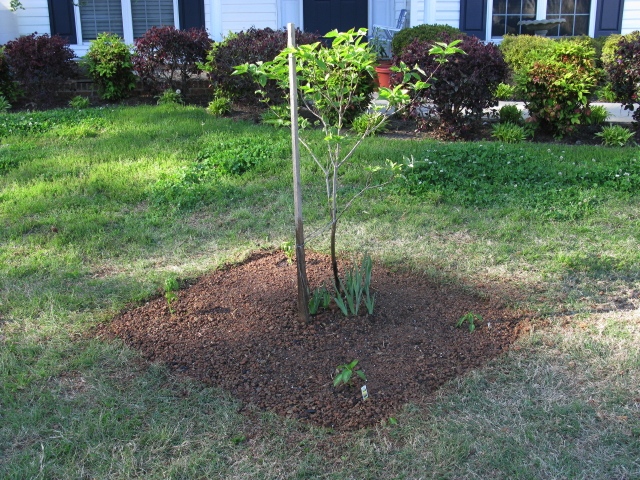
Here's how it looks today -- the two basil plants have doubled in height and breadth (I'm out there daily pinching off the new leaf pairs to force the basil to expand its breadth) and the two pepper plants, stripped of their leaves by a rabbit (?) the night after being planted, are putting out new leaves. The spinach, beets, and two kinds of kale are all growing well -- especially the kale:
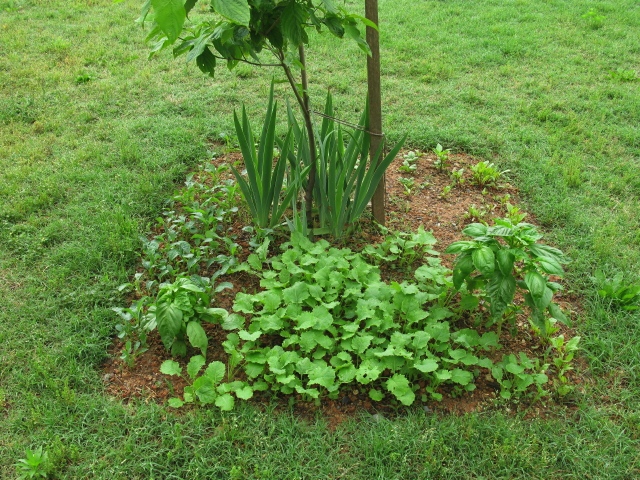
The little dogwood I planted last fall has been an interesting study. My neighbor got three dogwoods from the wooded property of a friend who lives in the country, and gave one to myself and my next door neighbor and kept one for himself. As a rule, dogwoods in the wild get "leggy" (grow tall and thin, reaching for sunlight that filters through the tree canopy). All three of our dogwoods looked the same when they were planted, but mine looks different: it has gotten bushy with leaves that are 2-3 times the size of the leaves on the other two. Here they are by comparison:
One of the neighbor trees:
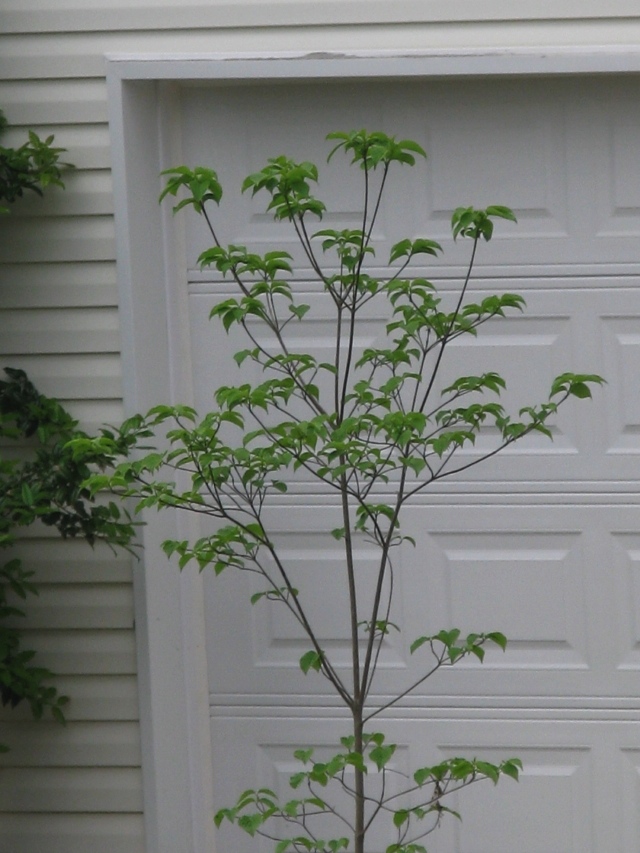
The other neighbor tree:
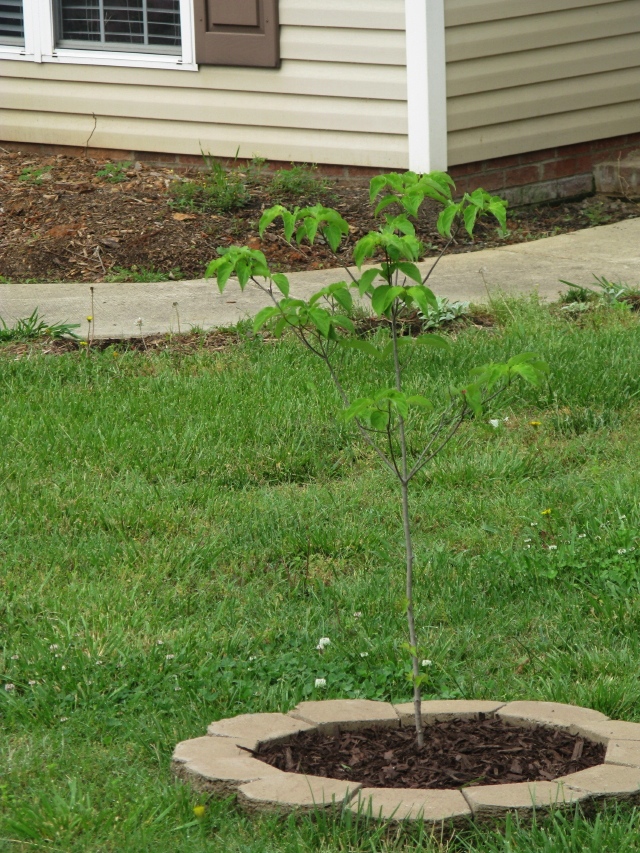
My tree -- notice how much it has grown out instead of just up, and how thick the foliage is compared to the other two. Don't misunderstand -- this is not for bragging rights -- it's to demonstrate the power of food. I have fertilized (fed) my tree consistently since last fall, whereas my neighbors have not. I don't know that my tree is healthier, but it is certainly more robust looking -- which I'm taking as a vote for diligent feeding. The size of the leaves on this tree are amazing. The neighbor who provided the trees came over the other day and wanted to know why mine looked different from his, and I offered him the same liquid concoction I created that I've used to water mine:
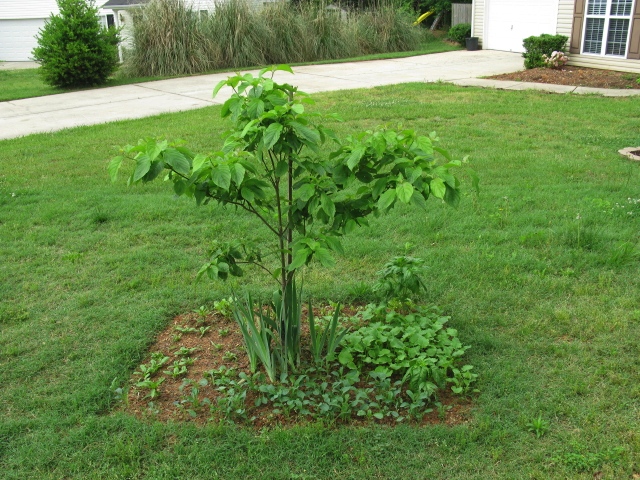
Some more pics -- including the first (tiny) tomato:

The eggplants are about to flower:

The planter-spinach is already being eaten for supper (thanks for the seeds, Priscilla):
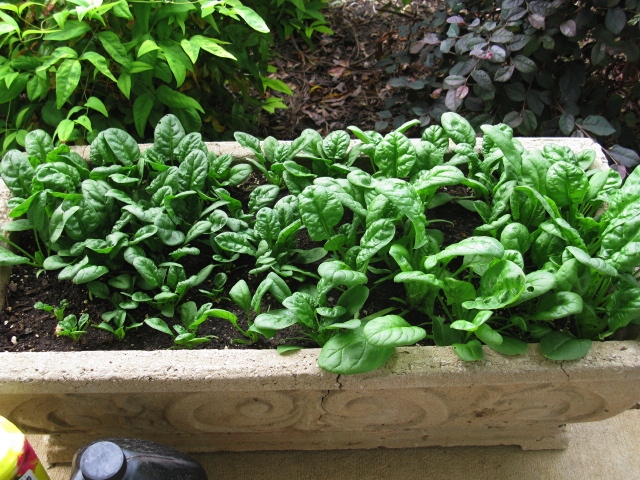
The little patch of Bordeaux spinach is growing:
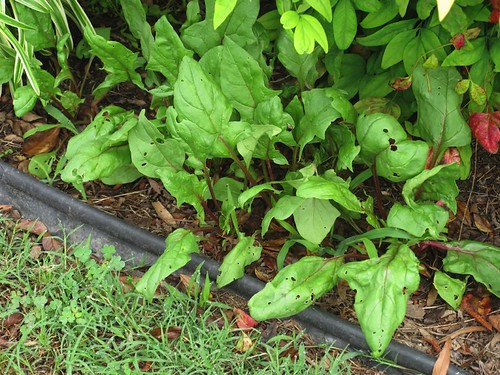
The chard is doing great -- along with five volunteer tomato plants that have come up in the midst of the bed from last year's dropped tomatoes:

The container herbs and veggies are healthy:

Especially this tomato -- it seems to love its pot, though I need to prune the suckers to divert its energy into fruit:
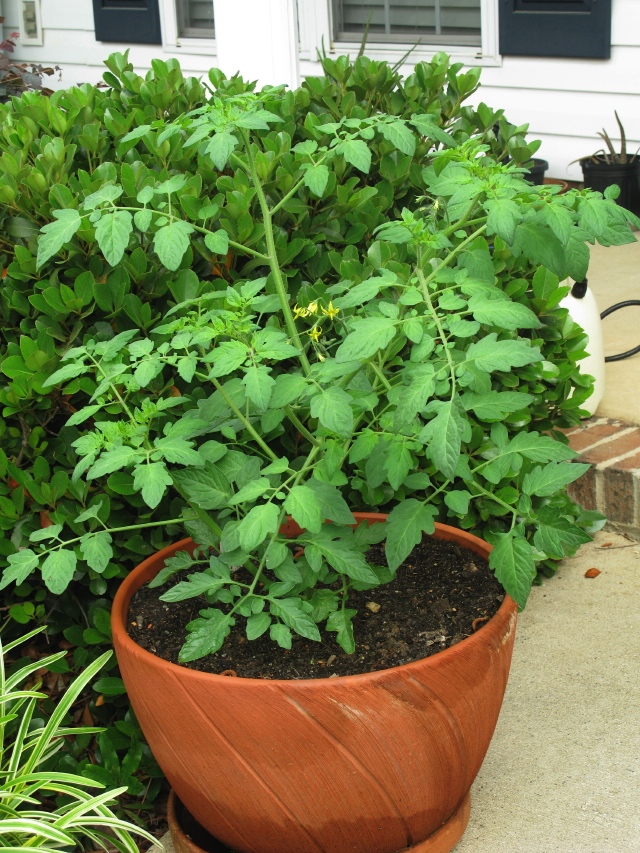
And the tomatoes/peppers (bottom) and bean/pea (top) buckets are doing well (the parsley in the end bucket didn't make it, so I'll take this bucket down and move it among the containers so the beans can get plenty of sun):
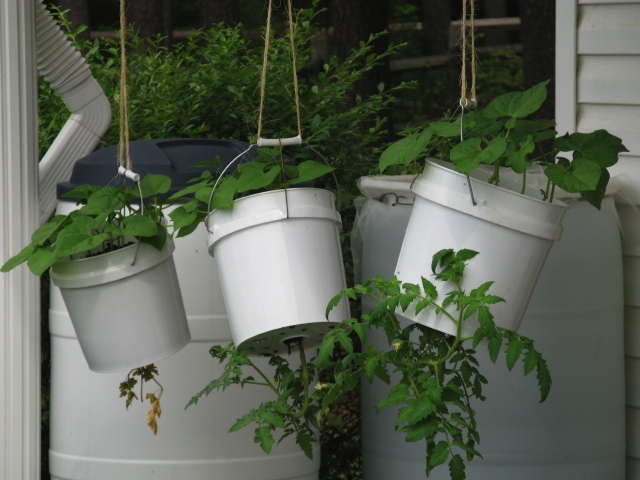
Another shot:
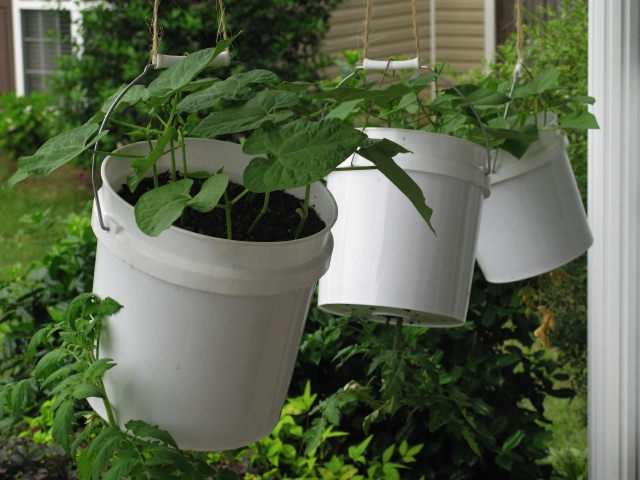
Beans (don't know the variety) from my neighbor on the top, cherry tomato on the bottom:
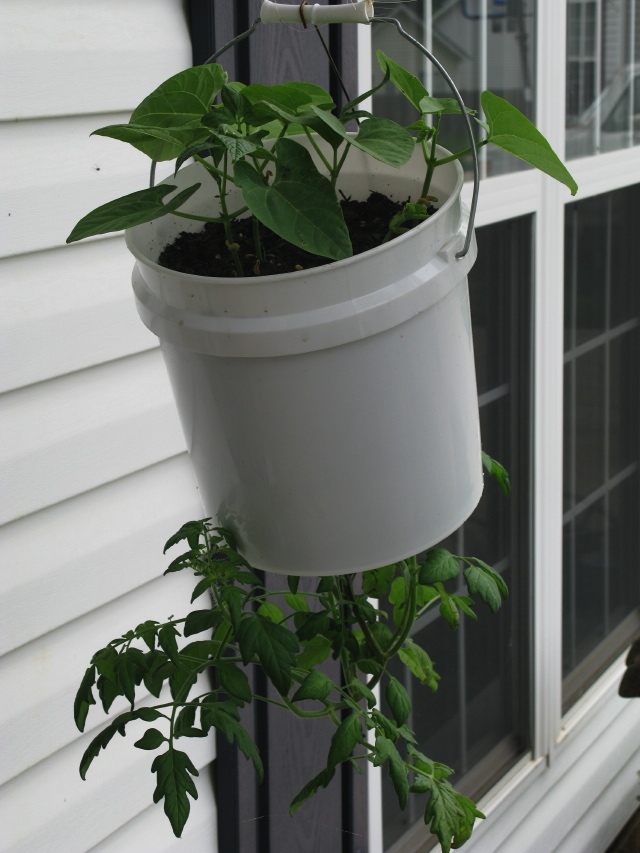
So far I'm encouraged by this idea -- though the beans are ultimately going to suffer without more sunlight -- still thinking about a solution:
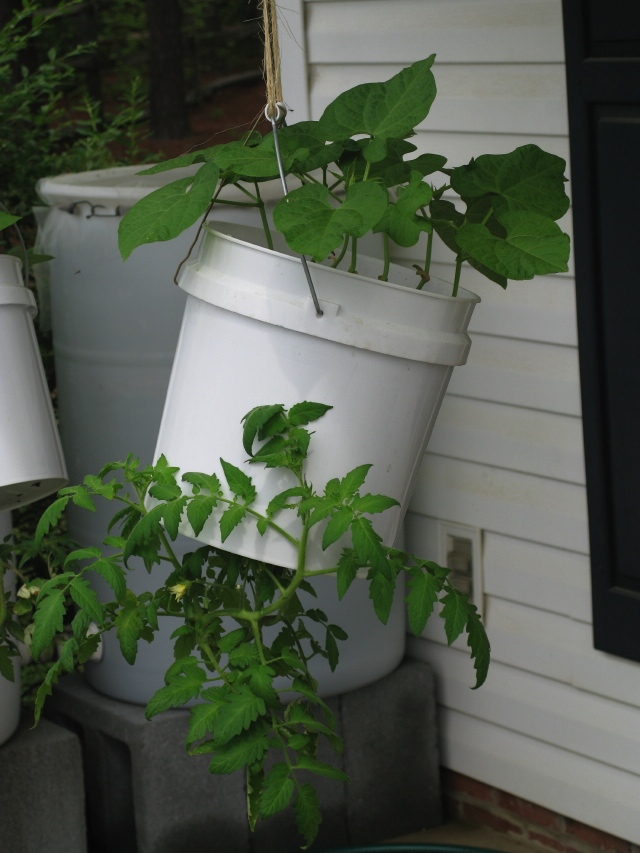
And yet more veggies to plant or give away -- these are from the seeds I started in the Winstrip tray. The seeds from my parents' yard in Alabama never made it, though I have saved the soil they were in. Who knows -- they might spring up someday:
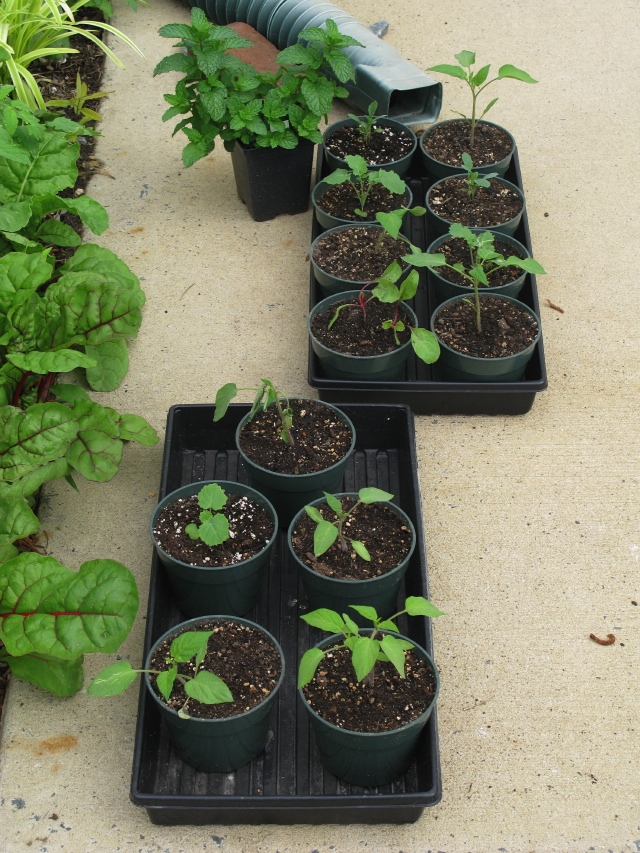
There is such pleasure in being around healthy, growing gardens. A taste of Eden-past and neo-Eden to come.

Here's how it looks today -- the two basil plants have doubled in height and breadth (I'm out there daily pinching off the new leaf pairs to force the basil to expand its breadth) and the two pepper plants, stripped of their leaves by a rabbit (?) the night after being planted, are putting out new leaves. The spinach, beets, and two kinds of kale are all growing well -- especially the kale:

The little dogwood I planted last fall has been an interesting study. My neighbor got three dogwoods from the wooded property of a friend who lives in the country, and gave one to myself and my next door neighbor and kept one for himself. As a rule, dogwoods in the wild get "leggy" (grow tall and thin, reaching for sunlight that filters through the tree canopy). All three of our dogwoods looked the same when they were planted, but mine looks different: it has gotten bushy with leaves that are 2-3 times the size of the leaves on the other two. Here they are by comparison:
One of the neighbor trees:

The other neighbor tree:

My tree -- notice how much it has grown out instead of just up, and how thick the foliage is compared to the other two. Don't misunderstand -- this is not for bragging rights -- it's to demonstrate the power of food. I have fertilized (fed) my tree consistently since last fall, whereas my neighbors have not. I don't know that my tree is healthier, but it is certainly more robust looking -- which I'm taking as a vote for diligent feeding. The size of the leaves on this tree are amazing. The neighbor who provided the trees came over the other day and wanted to know why mine looked different from his, and I offered him the same liquid concoction I created that I've used to water mine:

Some more pics -- including the first (tiny) tomato:

The eggplants are about to flower:

The planter-spinach is already being eaten for supper (thanks for the seeds, Priscilla):

The little patch of Bordeaux spinach is growing:

The chard is doing great -- along with five volunteer tomato plants that have come up in the midst of the bed from last year's dropped tomatoes:

The container herbs and veggies are healthy:

Especially this tomato -- it seems to love its pot, though I need to prune the suckers to divert its energy into fruit:

And the tomatoes/peppers (bottom) and bean/pea (top) buckets are doing well (the parsley in the end bucket didn't make it, so I'll take this bucket down and move it among the containers so the beans can get plenty of sun):

Another shot:

Beans (don't know the variety) from my neighbor on the top, cherry tomato on the bottom:

So far I'm encouraged by this idea -- though the beans are ultimately going to suffer without more sunlight -- still thinking about a solution:

And yet more veggies to plant or give away -- these are from the seeds I started in the Winstrip tray. The seeds from my parents' yard in Alabama never made it, though I have saved the soil they were in. Who knows -- they might spring up someday:

There is such pleasure in being around healthy, growing gardens. A taste of Eden-past and neo-Eden to come.



